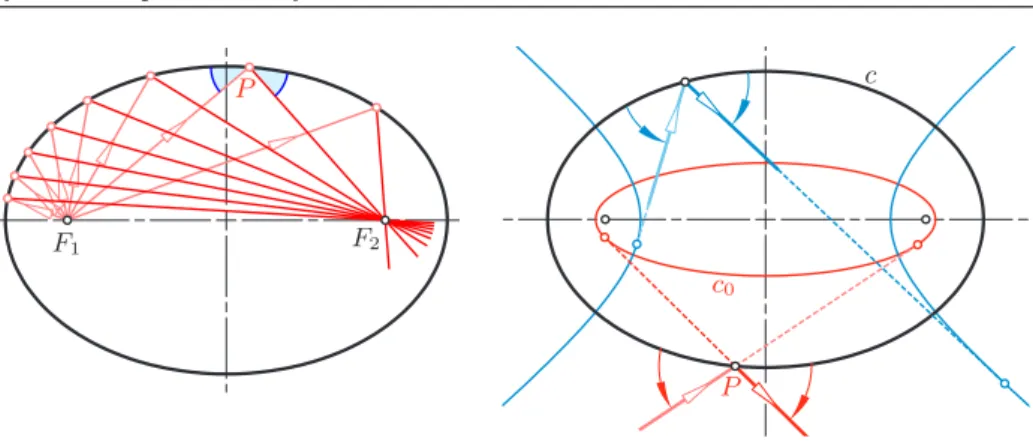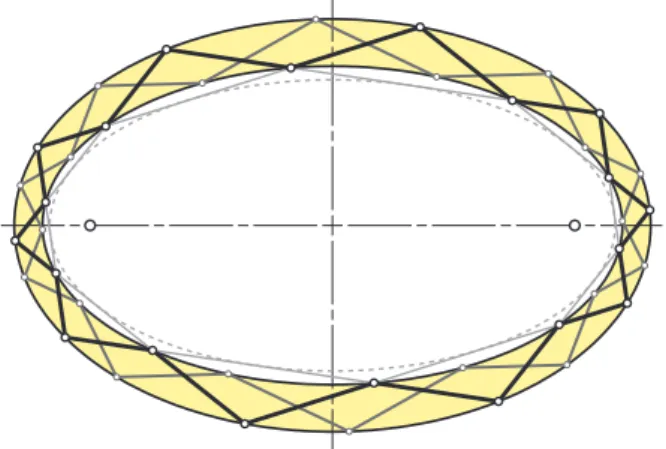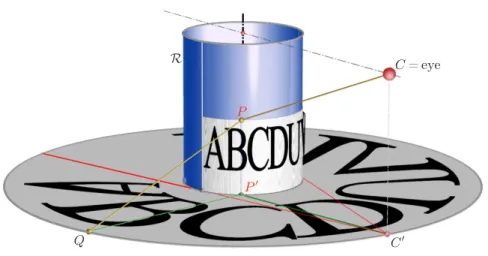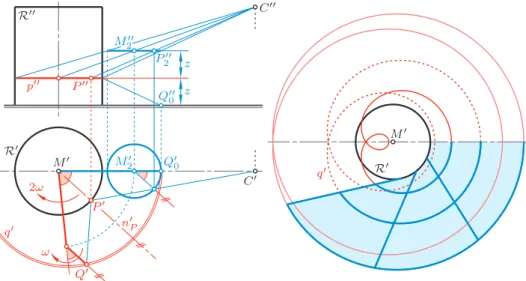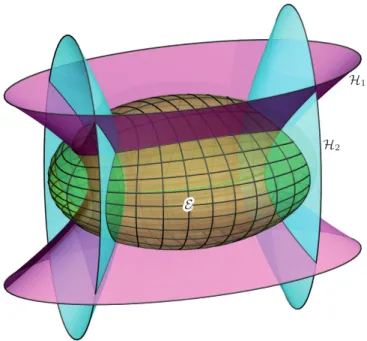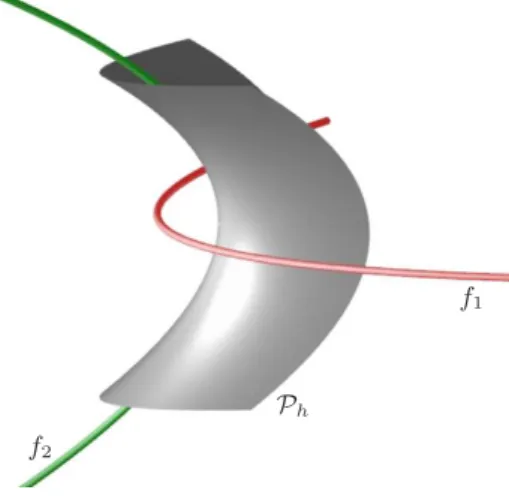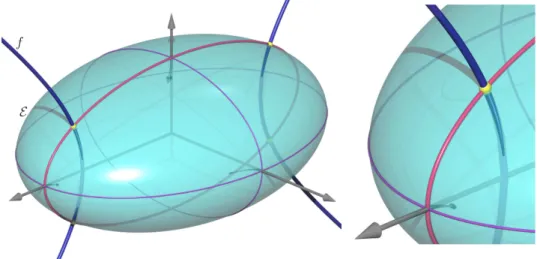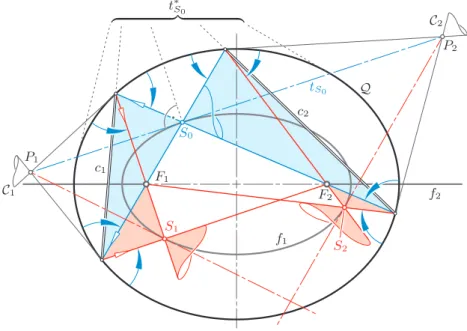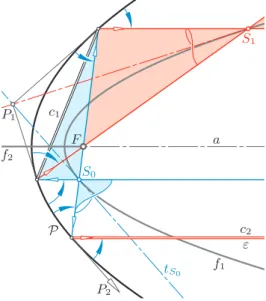Reflection in quadratic surfaces ∗
Hellmuth Stachel
Institute of Discrete Mathematics and Geometry, Vienna University of Technology stachel@dmg.tuwien.ac.at
Submitted March 5, 2018 — Accepted September 13, 2018
Abstract
“The transparent cup” is the title of pictures which show an interesting phenomenon: The circular boundaryc of the depicted plate appears as an ellipse which seems to coincide with the view of the reflection of c in the coffee-cup. Is this just by chance or is there a geometric theory behind?
In one example the circle c is the focal circle of the reflecting one-sheet hyperboloid, and for this particular case the displayed phenomen is a con- sequence of focal properties of quadratic surfaces. The tangent cones drawn from a fixed pointP to a family of confocal quadrics are confocal and have therefore coinciding axes. These axes are the surface normals to the par- ticular quadrics passing through P. Also the cones connecting P with the focal conics are included in the considered set of confocal cones. Therefore, all focal conics share the property: In each perspective, the images of these curves and their reflections belong to the same conic.
The goal of the paper is to highlight the geometric background, i.e., to focus on confocal conics and their spatial counterparts.
Keywords:confocal conics, confocal quadrics, reflection in quadrics MSC:51N20, 51N15, 68U05
∗The author is grateful to GeorgGlaeser, University of Applied Arts Vienna, for pointing his attention to this problem, and to MarkoKnöbl, who was the first who identified this surprising phenomenon and gave a geometric proof. Furthermore, the author expresses his thanks to these persons and to BorisOdehnalfor the permission to reprint their illustrations.
51
1. Reflection in conics and vertical cylinders
The stimulus for this article is a photograph showing a coffee-cup, which is made of ceramics and stands on a plate1. The cup looks transparent since the circular boundary of the plate is completely visible, even its section behind the cup. This apparent transparency is caused by the reflection in the cup: The mirror of the plate’s visible boundary appears as an exact continuation of itself. Similar effects can be seen in Figure 1. Is this incidental, or is there a theory behind?
Figure 1: Why does the bounding circle of the plate continue in the reflection? (By courtesy of KunoKnöbl[4])
Just to fix the terminology, we emphasize that under‘reflection’in a conic or quadric we understand the physical reflection and not the projective inversion in a quadric2. We study the physical reflection in its geometric idealization, which is defined as a transformation applied, in general, to non-directed lines l in the following way: at each pointP of intersection with the mirrorR, i.e., the reflecting curve or surface, the linel is reflected in the tangent planeτP or the normal line nP to R at P.3 The line l can have more than one point of intersection with R and hence more than one image. Note that each tangent line atP to Rremains fixed.
To begin with, we recall the optical property of conics (see Figure 2, left).
The reflection in an ellipse transforms rays emanating from one focus onto rays passing through the other focus. The same holds for hyperbolas when we ignore the orientation of the line. And finally, this optical property is also valid for each parabola when the ideal point of its axis is accepted as the second focus. Since the tangents drawn from a pointX to an ellipse share the angle bisectors with the pair of lines connectingX with the focal points [1, p. 42], we can formulate a more general optical property (see Figure 2, right).
1Seehttp://imgur.com/N10ESfl, retrieved April 2017.
2The latter is also known under the name ‘projective inversion’; it is a rational transformation where corresponding points are conjugate with respect to (‘w.r.t.’, in brief) a given quadric and collinear with a given center.
3In the two-dimensional case, the reflection in any smooth curve preserves the densitydp∧dϕ of oriented lines (satisfyingxcosϕ+ysinϕ=p). For further details note [3, p. 6].
F1 F2
c0
P Figure 2: Optical properties of ellipses
c0
c c0
c
Figure 3: Closed billiards with three or five reflections in an ellipse
Theorem 1.1. If any ray is reflected in a conic c then the incoming and the outgoing ray are tangent to the same conicc0 being confocal withc.
We recall that two conics are calledconfocalif they share the focal points. If in the family of confocal ellipses the minor semi-axis tends to zero the ellipse degener- ates into the segment bounded by the two foci. This reveals that the statement of Theorem 1.1 includes the original optical property, too. Analogous degenerations show up as limits of confocal hyperbolas or parabolas.
Iterated reflections of any ray producebilliards. Due to Theorem 1.1, billiards in an ellipse c are always circumscribed to another ellipse c0 being confocal with c. If one billiard inscribed in c and circumscribed to c0 closes after n reflections then all these billiards close, independently of the choice of the initial point on c (Figure 3). This is a well known example of a Poncelet porism [1, p. 429ff]. All these closed billiards have even the same length, due to Graves’ theorem (see [3] or [9] with much more details on billiards and reflections). By the same token, similar properties hold for billiards between two confocal ellipses (Figure 4).
We continue with a rather popular case of a reflection which is often used for producing anamorphoses [5]: Let a right cylinder R in vertical position be the
reflector. As illustrated in Figure 5, if observed from the center C, a point Q of the horizontal ground plane is visible at P ∈ R. We call P an reflected image of Q in R w.r.t. the center C. The surface normal nP to the cylinder at P is horizontal. Therefore the two segmentsP Qand P C of the reflected ray have the same inclination, andnP is the interior angle bisector of∠QP C, also, when seen in the top view.
As a consequence, for given centerCand pointQ, a reflected imageP ∈ Rhas its top viewP′on astrophoid, a curve of degree 3 [7]. This is the locus of pointsX in the ground plane such that a bisector of the angleQXC′passes through a given centerM′, which in our case coincides with the top view of the axis ofR(Figure 6).
Obviously, there is a second point of intersection between the strophoid and the cylinder R such that the interior angle bisector of ∠QP′C′ passes through M′. This shows that point Qcan (theoretically) have two reflected images P, P ∈ R;
the second oneP lies on the back wall.
Figure 7 shows also the trajectoryq ofQwhen a reflected imageP onRruns along the horizontal circle p ⊂ R. These trajectories are circular only in two particular cases: EitherP ∈ Rlies in the ground plane orP has exactly half of the height ofCover the ground plane. Otherwise, the trajectories arePascal limaçons.
This can be proved as follows (see Figure 7, left): The reflection atP ∈ Racts like the reflection in the surface normal nP and maps the line P C onto the line P Q. IfP has the heightzover the ground plane, then the reflection innP mapsQ onto a pointP2in the height2zon the lineP C . LetP run with angular velocity ω along the parallel circle p⊂ R. Then the intersection point P2 of CP with the plane in the height2zruns with the same angular velocityω on a horizontal circle p2with centerM2on the cone connecting pwithC.
In the top view we obtainQ′whenP2′∈p′2is reflected inn′P, which rotates with angular velocityω aboutM′. This shows that the trajectoryqofQis traced when a first bar M′M2′ rotates about M′ with angular velocity 2ω while a second bar
Figure 4: Closed billiards between confocal ellipses (20 reflections)
Q
P
P′
C= eye
C′ R
Figure 5: Reflection in a right cylinderR: pointQin the ground plane and a reflected imageP (by courtesy of GeorgGlaeser)
M2′Q′0 rotates with the (absolute) velocityω. A dyadM′M2′Q′0 moving this way generates as path of its endpoint a particular trochoid, namely a Pascal limaçonq′ [10, p. 155], provided that no moving bar has length zero.
2. Confocal quadrics
The word ‘quadric’ stands now for regular surfaces of degree 2, i.e., for those of full rank 4. Of course, surfaces of degree 2 can also be cylinders or cones (rank 3), pairs of planes (rank 2), or double-counted planes (rank 1). In the projective setting, when cones of degree 2 are regarded as sets of tangent planes, they are dual to conics.
Definition 2.1. Two quadrics are called confocal if they have common axes and they intersect each plane of symmetry along confocal conics.
Let E be a tri-axial ellipsoid with semiaxes a, b and c in standard position.
Then the one-parameter set of quadrics being confocal with E is given as x2
a2+k+ y2
b2+k + z2
c2+k = 1 for k∈R\ {−a2,−b2,−c2}. (2.1) In the casea > b > c >0this family includes (see Figure 8)
for −c2< k <∞ tri-axial ellipsoidsE,
−b2< k <−c2 one-sheet hyperboloidsH1,
−a2< k <−b2 two-sheet hyperboloidsH2. Their intersections with the plane z= 0share the focal points(±√
a2−b2, 0,0).
Iny= 0the common foci are(±√
a2−c2,0,0), and inx= 0 (0,±√
b2−c2, 0).
M′
C′ C′′
Q′ Q′′
P′ n′P P′
P′′
R′ R′′
Figure 6: For a given centerC and point Qin the ground plane the top views of the reflected images P andP lie on a strophoid
M′ M2′ M2′′
p′′ P′′
P2′′
P′ n′P q′
Q′0 Q′′0
Q′
C′ C′′
2ω
ω
z z
R′ R′′
M′ q′ R′
Figure 7: Parallel circlesponRare the reflected images of Pascal limaçonsqin the ground plane
EEEEEEEEE E EEEEEEE
H1
H2
Figure 8: Confocal quadrics intersect mutually along their curva- ture lines (by courtesy of BorisOdehnal)
As limits fork→ −c2 andk→ −b2we obtain ‘flat’ quadrics, i.e., the the focal ellipse fe: x2
a2−c2 + y2
b2−c2 = 1, z= 0, the focal hyperbola fh: x2
a2−b2 − z2
b2−c2 = 1, y= 0.
These two conics form a pair of focal conics: each is the locus of apices of right cones passing through the other conic [1, p. 137ff]. As a member of the confocal family, the two focal conics have to be seen as sets of tangent planes. Then they are rank 3 quadrics. According to this interpretation, all lines in space which meet any focal conicf in at least one point, aretangent linesoff. When below we speak of a proper tangent line, then we mean an ordinary tangent of the plane curvef.
The quadrics being confocal with an elliptic paraboloidPe can be represented
as x2
a2+k + y2
b2+k−2z−k= 0 for k∈R\ {−a2,−b2}. (2.2) In the casea > b >0this one-parameter set includes
for −b2< k <∞ or k <−a2 elliptic paraboloidsPe,
−a2< k <−b2 hyperbolic paraboloidsPh.
For all k, the vertices of the paraboloids have the coordinates(0,0,−k/2). Point (0,0, b2/2)is the common focal point of the principal sections in the plane x= 0, and(0,0, a2/2)is the analogue for the sections withy= 0.
Ph
f1
f2
Figure 9: A hyperbolic paraboloid Ph together with its focal parabolasf1 andf2(by courtesy of GeorgGlaeser) The limits fork→ −a2 ork→ −b2define the pair offocal parabolas
y2
a2−b2 −2z+b2= 0, y= 0, x2
a2−b2 + 2z+a2= 0, x= 0
within the confocal family (Figure 9). For this pair of parabolas (compare with [1, Fig. 4.15] holds the same as mentioned above for an ellipse and its focal hyperbola.
For the sake of brevity, we ignore here the special cases of confocal quadrics of revolution. However, we recall that confocal quadratic cones can be given as
x2
a2+k+ y2
b2+k− z2
c2−k = 0, k∈R\ {−a2,−b2, c2}. (2.3) Their intersections with the unit sphere result in confocal spherical conics. If a > b >0 then fork≥c2 andk≤ −a2 the cones do not contain real points other than the origin. The ‘flat’ limit fork→ −b2 is a sector bounded by the lines
√ x
a2−b2 ± z
√b2+c2 = 0 (2.4)
in the planey= 0. These linesg1, g2are calledfocal linesorfocal axesof the cones, since they pass through the focal points of the corresponding spherical conics [1, p. 436ff]. The optical property, as shown in Figure 2, left, is also valid for spherical
focal axisg1into planes through the other axisg2.
In the case a = b we obtain confocal cones of revolution. Their focal axes coincide in the common axis of revolution.
Theorem 2.2. In dual setting, confocal quadrics form a one-parametric linear system (range) of quadrics sharing the isotropic tangent planes. Hence, the range includes the absolute conic as a rank-3 dual quadric.
Similarily, confocal quadratic cones form a range, which includes the isotropic cone with the same apex. Since pairs of isotropic tangent planes of a quadratic cone intersect along a focal axis, confocal cones have common focal axes.
Proof. In order to obtain the tangential equations, we note that the plane satisfying u0+u1x+u2y+u3z= 0
is tangent to any surface of the confocal family (2.1) if and only if (−u20+a2u21+b2u22+c2u23) +k(u21+u22+u23) = 0.
This is a linear combination of the homogeneous dual equation of E and that of the set of isotropic planes. The homogeneous dual equations of confocal parabolas satisfying (2.2) have a similar form, namely
(a2u21+b2u22−2u0u3) +k(u21+u22+u23) = 0.
Finally, the dual equations of confocal cones, as given in (2.3), are u0= 0, (a2u21+b2u22−c2u23) +k(u21+u22+u23) = 0,
and they show again a range, spanned by the given cone(k= 0)and the isotropic cone with their common apex at the origin.
Theorem 2.3. The cones or cylinders drawn from any finite or ideal point P tangent to the quadrics of a confocal family or connectingP with one of the included focal conics are confocal. For finiteP, the common and mutually orthogonal planes of symmetry of these confocal cones are tangent to one of the three quadrics passing through P.
Proof. The considered tangent cones share all isotropic planes which are common to the confocal quadrics and pass throughP. Hence, the cones are confocal, too.
This is a classical result attributed to C. G. J.Jacobi1834 [8, p. 204] and a special case of a theorem concerning ranges of surfaces of degree 2.
The tangent cone fromP to a quadricQ splits into pencils of planes with two real or complex conjugate axes if and only if Q passes through P. Then the two axes are generators ofQand span the tangent plane atP. On the other hand, the planes spanned by the axes of singular cones are the common planes of symmetry of the confocal cones. This confirms that confocal quadrics form a triply-orthogonal system of surfaces.
Let a tangent linelof a quadricQ0pass through any pointP on the quadricQ being confocal withQ0. Then, by virtue of Theorem 2.3, the reflection oflatP in Qis again tangent toQ0, since the tangent planeτP toQis a plane of symmetry of the cone of tangents drawn fromP to Q0. Thus we obtain the spatial analogue of Theorem 1.1.
Corollary 2.4. LetQandQ0 be two different quadrics in a confocal family. Then the reflection inQmaps the line complex of tangents ofQ0onto itself. In particular, the complex of lines meeting any focal conic f of Qremains fixed.
We only report that, in general, a given line contacts two surfaces of a confocal family, and the tangent planes at the respective points of contact are orthogonal (see, e.g., [9, p. 65]). This can be concluded from the spatial version of the De- sargues involution theorem. However, there are exceptions, called focal axes [8, pp. 205–206]: Such a linelhas the property that the isotropic planes throughl are tangent to any quadric and therefore to all confocal quadrics.
Lemma 2.5. Each focal axis l of a quadric Q is either a generator of a ruled quadric confocal with Q or a proper tangent of a focal conic ofQ. At each point P ∈l, the focal axisl of Q is also a focal axis of the cone drawn from P tangent toQ or to any other confocal quadric.
Proof. Each plane through a generatorlof a ruled quadric is tangent to this quadric at a particular point ofl. Therefore also the isotropic planes throughl touch the quadric.
The tangent cone or cylinder with apexP comprises all tangent planes ofQwhich
E f
Figure 10: The perspective of the focal hyperbola coincides with its reflected image in the ellipsoidE (by courtesy of BorisOdehnal)
planes throughlare tangent to the cone and, hence, also toQ.
Corollary 2.4 is the main reason for the optical effects mentioned at the begin- ning (Figure 1): Let a quadricQ and a central projection with centerC be given.
If any line l of sight, which meets a focal conicf of Qat a point Q1, is reflected at the point P 6= C in Q, then the transformed line still meets f at any point Q2. Hence, the perspective images of pointQ1 and P are coinciding, where P is the reflected image of Q2 w.r.t. C. This holds for all Q1 ∈ f. Therefore in the perspective the focal conic f and its reflected image in Q w.r.t.C belong to the same conic (“Theorem of the Transparent Cup”).
The quadric in Figure 1 is a one-sheet hyperboloid of revolution, andf passes through the focal points of the meridians. In Figure 10 we have a reflecting ellipsoid E and its focal hyperbolaf.
We can even replace the focal conic f by any other quadric in the confocal family and claim, as given below.
Corollary 2.6. Let a reflecting quadricQbe given together with a confocal quadric Q0. Then in a perspective with any centerC, the quadricQ0and its reflected image inQw.r.t.Chave coinciding contours. This is also valid whenQ0degenerates into a focal conic f: The perspective of f coincides with that of its reflected image in Q.
3. Reflecting cones in a quadric
By virtue of Theorem 2.4, a line meeting a pair of focal conicsf1andf2keeps this property after reflection in any quadric being confocal with f1 andf2. The set of such lines is the union of cones of revolution with apices on the focal conics. Now we check what happens if the generators of one of these cones are reflected.
Theorem 3.1. Let Q be a quadric with focal conics f1 and f2. The cone C0 of revolution, which connects any pointS0∈f1 withf2, intersectsQalong two conics c1 andc2. The reflection in Qalong the conic ci,i= 1,2, transformsC0 again in a cone Ci of revolution passing throughf2 with an apex Si∈f1 (Figure 11).
Proof. The tangent cones drawn from point S0∈ f1 to the quadrics of the given confocal family are confocal with the cone C0 connecting S0 with f2. Since the latter one is a cone of revolution, they all are cones of revolution with the proper tangent tS0 to f1 at S0 as their common axis. These cones are tangent to the isotropic planes through tS0; the respective lines of contact are isotropic lines in the plane orthogonal totS0 throughS0.
On the other hand, the poles of a fixed plane w.r.t. the quadrics of a range are collinear. For each isotropic plane throughtS0, which touches all quadrics confocal withQ, the points of contact are alined with two points: S0 as the touching point withf1, and the respective absolute point as the touching point with the absolute
F1
F2
S0
S1
S2
P1
P2
f1
f2
c1
c2
C1
C2
tS0 Q t∗S0
z }| {
Figure 11: The reflection in the quadric Q transforms the right cone with apexS0∈f1onto two right cones with apicesS1, S2∈f1
conic. Hence, the quadricQ, like any other confocal quadric, contacts the coneC0 at two points. Consequently, the curve of intersectionQ ∩ C0 splits into two conics c1and c2, both passing through the points of contact on the linet∗S0, polar totS0
w.r.t. Q. Figure 11 shows the scene after being orthogonally projected into the plane of the focal conicf1.
Let Pi denote the apex of the tangent cone Ci of Q along ci fori = 1,2. In accordance with Lemma 2.5, the two proper tangents drawn from Pi to f1 are the focal axes ofCi. One of them is tS0, the other contactsf1 at Si (Figure 11).
As already noted, the reflection in Ci transforms planes through tS0 into planes throughPiSi. Due to the contact betweenCiof Qalongci, for each pointX ∈ci
the reflection in Q maps the line S0X onto a line meeting the axis PiSi. On the other hand, by virtue of Corollary 2.4, the reflected line must also meetf1(andf2).
Hence, the reflection ofS0X coincides withSiX, as stated in Theorem 3.1. For all X ∈ci, the planes spanned by the incoming and outgoing ray, which contain also the surface normalnX to Q, have the common traceS0Si in the plane off1.
The given proof reveals that Theorem 3.1 can be generalized by replacing the focal conicf2with any confocal quadricQ0.
Theorem 3.2. Let Q andQ0 be two confocal quadrics. Then the reflection inQ transforms each cone of revolution, which is tangent to Q0, into two cones of the same type.
reflection in a general quadric correspond again to a cone, are those mentioned in Theorem 3.2.
From a limiting case of Theorem 3.1 we learn how the well known reflecting property of a satellite-TV receiving dish changes when the paraboloid of revolution is replaced with a general elliptic paraboloid.
F S0
S1
P1
P2
f1
f2
c1
c2
ε a
tS0
P
Figure 12: The reflection in the elliptic paraboloid P transforms the right cone with apex S0 ∈ f1 onto the right cone with apex S1∈f1 and a pencil of lines parallel to the axisain the planeε
Theorem 3.4. Let P be any paraboloid other than a paraboloid of revolution.
Then the reflection in P maps all lines l being parallel to the axis a of P onto lines meeting both focal parabolas f1andf2 ofP. The pencil of those parallels l to a, which lie in a plane ε orthogonal to the plane off1, is mapped onto a cone of revolution with apex S0∈f1.
The latter can also be concluded as follows (see Figure 12). Letc2 denote the parabola P ∩ε. The tangent cone of P along c2 is a parabolic cylinder C2 with apexP2 at infinity. After an orthogonal projection with centerP2 the cylinderC2 appears as a parabola C2n. In this view the reflection in Q along c2 is seen as a planar reflection in C2n which transforms lines parallel to the parabola’s axis onto lines through the focus ofC2n. This focus coincides with the view of S0, which is the point off1 with the proper tangenttS0 passing throughP2.
Remark 3.5. The bundle of parallels to the axisaof the paraboloidP consists of all lines orthogonal to a plane. By virtue of the Theorem of Malus and Dupin [6, p. 446], the property of being anormal line congruenceis preserved under reflection
in a surface. The surfaces orthogonal to the lines meeting the pair of focal parabolas of P are parabolic Dupin cyclides [1, p. 147ff]. We recall that the surfaces, whose normals intersect an ellipse and its focal hyperbola, are general Dupin cyclides.
References
[1] Glaeser, G., Stachel, H., Odehnal, B.,The Universe of Conics, Springer Spec- trum, Berlin Heidelberg 2016.
[2] Glaeser, G., Odehnal, B., Stachel, H., The Universe of Quadrics, Springer Spectrum (in preparation).
[3] Izmestiev, I., Tabachnikov, S., Ivory’s Theorem revisited, Journal of Integrable Systems 2/1, xyx006 (2017)(https://doi.org/10.1093/integr/xyx006).
[4] Knöbl, M., The Transparent Cup Theorem, Retrieved from [http://karuga.eu/
transparent-cup.html], 2016.
[5] Mazzalai, S., Between Memory and Innovation: Algorithmic Analysis of some Catoptric Anamorphoses by Jean François Niceron,Proceedings of the 17th ICGG, Beijing 2016, no. 27.
[6] Pottmann, H., Wallner, J., Computational Line Geometry, Springer-Verlag, Berlin 2001.
[7] Stachel, H.,Strophoids are auto-isogonal cubics.G – Slovak Journal for Geometry and Graphics, ISSN 1336-524X,12, no. 24, 45–59 (2015).
[8] Staude, O.J.,Flächen 2. Ordnung und ihre Systeme und Durchdringungskurven, in Encyklopädie der math. Wiss.III.2.1, no. C2, 161–256, B.G. Teubner, Leipzig 1915.
[9] Tabachnikov, S.,Geometry and Billiards,American Mathematical Society, Provi- dence/Rhode Island 2005.
[10] Wunderlich, W.,Ebene Kinematik,Bibliographisches Institut, Mannheim 1970.
![Figure 1: Why does the bounding circle of the plate continue in the reflection? (By courtesy of Kuno Knöbl [4])](https://thumb-eu.123doks.com/thumbv2/9dokorg/1203038.89521/2.722.143.575.283.446/figure-bounding-circle-plate-continue-reflection-courtesy-knöbl.webp)
